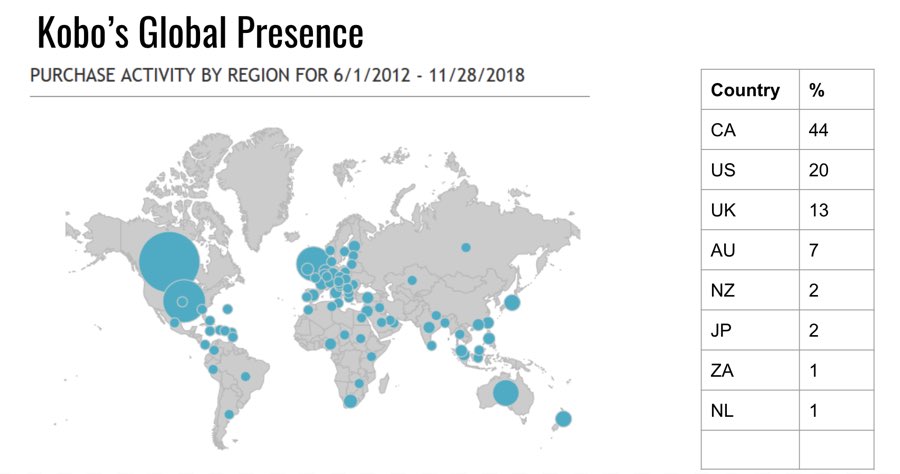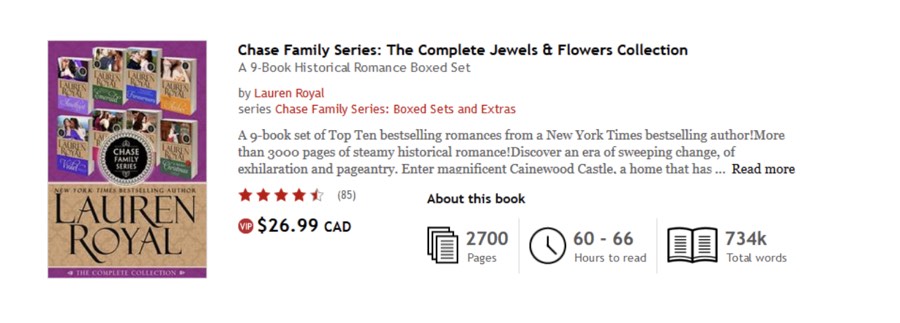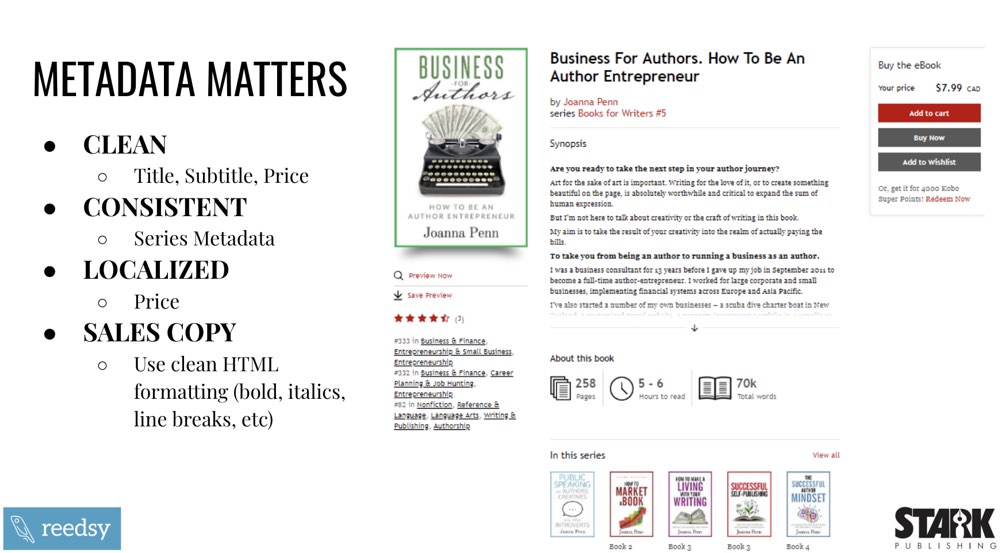The Big Questions
What is Kobo? Why is Kobo important, how does it work, and how is it different from Amazon? The question often comes up: should I publish directly to Kobo or with a distributor? There are pros and cons for each and I'm going to be completely transparent and walk through whatever works for you.
Understanding Kobo
So... jumping right in. Even if you're doing really, really well in a place like Amazon — if you're only selling there, then you're missing out. Let's look at the places where Kobo retails in — which is in 190 countries. This is a map of my Kobo Writing Life dashboard map of my sales since almost day one of the platform:

The blue dots represent where in the world my books have sold.
As you can see, the larger the blue dot, the higher the percentage. So countries like Canada and Australia are very typically the top-selling regions for most authors. Me specifically, about 44% of my sales at Kobo come from Canada, then 20% US. Then 13 UK, then Australia, then New Zealand, then you get into a whole bunch of other countries.
Thinking about that global presence, we're not just talking about kobo.com — but also the retail partnerships that Kobo has. And that's a bit part of the differences between a place like Kobo and a place like Amazon. When you're looking at Kobo, your book's not available just at their online store, it's also available at the bookseller retail partners in the various countries:
- Chapters/Indigo (CA)
- Walmart, Best Buy, Future Shop (CA, US)
- WHSmith & Waterstones & Sainsbury’s (UK)
- American Booksellers Association (indie bookstores) US
- Rakuten (JP)
- FNAC (FR)
- Mondadori and La Feltrinelli (IT)
- BOL (NL)
- Independent Bookstores (NZ)
- Angus & Robertson (AU)
You've probably heard the news recently in the last few months that Kobo just partnered with Walmart in the US. So when you're buying Ebooks from Walmart, and you can even see the branding there with that Walmart star, it's powered by Rakuten Kobo.
In Japan, Rakuten (which owns Kobo) is a significant player there. They are Amazon-sized in Japan. They are also partnered with the American Booksellers Association in the US, and around 600 independent bookstores across Canada through indiebound.org. One of the other larger partners that's very significant is bol.com in the Netherlands — where you can also benefit from Kobo Plus.
Understanding the global base
When you sell your book through Kobo, you not only list it on kobo.com and bol.com, but you can also list it on Kobo Plus. Think of it like Kindle Unlimited without the exclusivity clauses. It's a subscription-based programme with royalty sharing for everyone whose books are read in that time period.
So, in the Netherlands and Belgium, which are the only two territories where that exists, your book can be listed as regular on Kobo and Bol. Also... you can register it on Kobo Plus withon both platforms and receive their 20% rate. It's like four listings for the price of one.
In France, the retailer FNAC (which is like if Best Buy and Barnes and Noble had a baby) has all of the books, the music, the entertainment, and the electronics. And Kobo, of course, powers their Ebooks. And they're very in Spain as well. The point is that when you think about Kobo, you really should be thinking about their powerful local partners. This of is one of the big differentiators for Kobo compared to Amazon.
If you understand that Kobo's about partnering with local retailers, rather than taking over and dominating the market, you have a better understanding of what may work with Kobo.
It's all about books
Because Kobo was born out of Chapters/Indigo here in Canada, the company still has a lot of that traditional bookselling DNA. There's a significant difference between the way that the inmates run the asylum at Kono than how it's done at Amazon for example, where 90% of it's algorithm-based. At Kobo, there's a lot of algorithms going on in the background, but there's also a lot of human merchandising. And we're going to talk about that in a little bit more detail.
Royalty Structure at Kobo
Now when we're talking about maximizing royalties, most people think of pricing their books between $2.99 to $9.99. On Amazon, that's where your price point needs to be if you want to get your 70% royalty. Well on Kobo, there's no cap on the 70%, which is really important for selling higher priced items.
And if you price under $2.99, you're actually making 45%, not 35% which is what you get at Amazon. It's a small difference, but hey, every 10% in your pocket is a good 10%. There's also no delivery cost based on ePub file size, which you'll also see on Amazon. So when you're making 70% on Amazon, you're really not making 70%. You're making 70% minus that whisperer sync fee that they have that's built in. You're really probably making 69.1% or something like that.
A difference in scale
So here's an important factor to remember, is when you're publishing to Kobo, you're not going to see results right away.
On average, I remember seeing, it would take six to nine months for an author to actually gain a foothold. Now one of the reasons is, so Amazon's huge in the US. There are 326 million people in the US. Kobo is huge in Canada, but the population of Canada is about the equivalent of the state of California. So that's something that when you think about that, what is that 17 million folks in Canada? That's a relatively small number.
And that's usually why for every 10 books you'd sell on Amazon, you'd be selling one on Kobo.
Your distribution options
There are two main options for publishing with Kobo. You can go direct via Kobo Writing Life, or you use a third party distributor. And there are multiple options, but yes, I work for Draft2Digital because I love and respect Draft2Digital. But Smashwords has been around from the beginning of time as a way to get into Kobo. There are other companies globally as well like StreetLib and PublishDrive that authors might use.
The one way I would caution you not to publish your ebooks to Kobo is, as much as I love them, IngramSpark. They're fantastic for POD and print on demand distribution but not as good at Ebooks. I would go with one of these other distributors. I'm obviously bias toward Draft2Digital, but again, it's your choice on how to do that.
The pros of publishing directly with Kobo Writing Life
- You get direct control,
- You get the full 70% royalty, and
- Most importantly, you get that built-in promotional tool that we'll talk about later.
The pros of using a distributor
- You save time.
Sure, you give up 10% or you're making 60% instead of 70%, but instead of publishing to five different platforms, you publish to one and you only make the change once. So if you're getting a book pub deal or you're doing some sort of promo through a written word media company for example like Bargain Booksy, or on E-rater News Today, you don't have to log in five times and change your price five times. And for some authors, especially those who don't have virtual assistants, that takes time.
Similarly, having one platform where you can take care of payment, sales, and reporting will save you some time.
Global Pricing
So moving onto the next step, and this is some of the details that you need to really pay attention to. And it goes back to that global, is pricing. And it really, really matters what you're doing. Localized and natural looking prices are critical.

Here is the tool in Kobo Writing Life that allows you to price globally. Now because I'm in Canada, mine is going to show me CAD as a default. But it's really important not just to enter a US price and leave it. It's really, really important to go in and take control of your global pricing. And one of the things that's recommended is to round each local price to the nearest 99 cents. And the reason behind that logic is relatively simple.
Let's say you book priced at $4.99 US dollars. Today's exchange rate to Canadian dollars is 1.3 or something. So imagine that maybe comes to $6.27. When a customer sees a price of $6.27, they've automatically rounded it up to $7.00 in their head. It's a psychological thing that we always do. So you have two choices:
- you can round up to $6.99 or
- you can round down to $5.99
In the customer's mind, they're already paying that next dollar. And if it's already within that dollar range, even based on the economies of scale in Canada and Australia for example, where books are ridiculously overpriced, going up to that next .99 usually just means an extra 50 or 60 cents in your pocket. What I'm not suggesting is ripping off customers in Canada and Australia. Book pricing in different countries follow different parameters and following those globally is going to probably help you on Kobo a lot more than it ever would on Amazon.
In pounds and in euros, when you're looking at the pricing, you can go back to 99 cents or 49 cents. And the reason for that is the euro and the pound are usually significantly stronger than the American dollar. Consumers in Europe and the UK are used to prices that have the 49 or the 99 price point.
I want to remind authors is when you sign a contract with Kobo (or with any of the retailers like Kindle), you agree that your price will not be lower on any other retail price. It's actually in the fine print of every single contract you sign with a retailer. So when I'm talking about changing your pricing, I'm assuming you're going to change them on all platforms consistently.
S0, what are the right prices for Kobo?
Pricing at Kobo is different because it was born out of traditional merchandising and retailing. A lot of their price practices are based on working with big publishers. From what I remember seeing, the average list price across all fiction would be about $7.50. Most of the titles south of that were from indie authors, and most of the titles north of that were from larger traditional publishers.
So there was usually a bit of a variance where Indie authors could stand to walk the price point up just a little bit more — not to rip off customers, but to be more in line with the average price points. This is one of the ways I like to describe how the humans at Kobo make a difference. The only way that Kobo makes money is when you sell books. They do sell e-readers, but their primary source of income is selling ebooks.
So imagine a merchandiser is looking at two titles at the same time. And it's a brilliant thriller, and it's everything that everyone wanted it to be. It's the next Gone Girl, it's the next Suzanne Collins, the next J. K. Rowling title. It's a beautiful book. It's precisely what they want to merchandise. Both of them are perfect for audience. And the merchandiser wants to feature it on the main page or in an email blast. The one book, let's say is 99 cents. And the other book is $9.99. This is what's going through the merchandiser's mind.

Okay, on the 99-cent one:
- the author/publisher gets 45 cents
- Kobo keeps 54 cents.
The book that's $9.99:
- the author gets $7.00
- Kobo keeps $3.00.
Assuming everyone at Kobo wants to make money and keep their jobs — and assuming that titles will sell about the same number of units if they are featured, which one do you think they're more likely to feature? By only focusing on bargain basement prices, you're making it really hard for a Kobo merchandiser to select your beautiful, perfect title.
TIPS: Catching a Merchandiser's Eye
Your title's base price will also affect how well your promos perform. Take, for example, the monthly 30% off promos that work really, really well on Kobo: 30% off of a book that's priced $2.99 is nowhere near as good a deal as 30% off a book that's priced $6.99. From the customer's point of view, that 30% is a much more significant chunk of change.
Take a look at this box set, priced at $27 Canadian.

It's the Chase Family series, a nine-book historical romance box set of the entire series of books that she had at the time.
She included it in one of those 30%-off promo features from Kobo. And because obviously the cover was beautiful and the price point was excellent, one of the merchandisers said, "Hey, I like this cover. I'm going to stick this as the number one book in our email blast that goes out to the targeted customers."
And Lauren woke up the next day to find that this book was number one on Kobo. And it was number one for a few days in a row. And considering that there's no price cap on Kobo (same as Apple books), she was making 70% of $27 Canadian. So you don't need to sell 100,000 copies at 99 cents to make real money on this. She was making really, really good money on this right away.
Again, it was a little bit of the luck of the draw, but it was also evidence that an Indie author can actually charge a significant amount of money. Now keep in mind, this is 60 to 70 hours worth of rating 2,700 digital pages to read. This is almost a million words.
Metadata Matters
Have a look at this example from Joanna Penn.

What you'll see is a clean title and subtitle, very clean metadata and a clear series title. Jo worked on the sales copy and taken advantage of the HTML formatting when she submitted this title.
Series Metadata
At the bottom, you'll see that she entered in the "series" field within Kobo Writing Life or in a place like Draft2Digital that allows you to enter the series information. That way, Kobo is automatically merchandising that for her and telling users that it's a part of a more extended set of books.
The series metadata is consistent; therefore she's actually leveraging the built-in algorithms that Kobo has. But she's also made it easy for a merchandiser who sees this book come up on a sales report. Let's say she booked a BookBub spot that has spiked the sales. Then, all of a sudden, it catches the merchandiser's eye, and they're looking at it.
"Oh my goodness, she has a whole series of very similarly branded books," they're thinking. "Maybe there's a promo that we can include with some of the other ones." Because if customers like this one book, they might like the other one. And that's how that can link back.
Localized Prices Across the Board
They'll also recognize that it has localized prices. So if you go into Kobo and you click on that little US flag or Canadian flag or the UK flag at the very top of the screen on kobo.com, it'll default to whatever country you're in. You can actually see what the pricing looks like in other countries. And so Joanna's one of the authors who does that. She pays attention to what the market will bear in different countries.
She very consistently prices her books in those five main English language territory currencies. And local merchandisers, because Kobo has merchandisers not just in the Toronto office, but they actually have merchandisers focused on countries around the world who pay attention to what's going on in the UK, and what are UK people interested in and how does that sync up with W. H. Smith, the partner in the UK? And how does this title from France sync up with what the Netherlands wants to do? And are the prices localized to euros in a nice, clean looking price?
Those are the subtle things that immediately shows a merchandiser whether or not this is an amateur or a professional.
Leveraging Pre-Orders
We live in a brilliant world where once your book is ready, you push the publish button and it's live, often within hours. That's an exhilarating time for us. But because Kobo was born out of traditional retailing, they're used to working with sales reps from publishing companies who usually have a six month lead time. And they often will plan their promos six to 12 weeks out. So if you were to approach someone from Kobo and say, hey I've got this great title. It's launching next week, they won't be able to help you out.
That's where a long pre-order window can help you out. By engaging in a practice that's more in line with what the larger publishers are doing — planning things out and letting retailers know well in advance — there may be an opportunity for the merchandisers and the people who work at Kobo to find a place for it.
And it is challenging to get pre-order attention without a previous track record. If you DO have one, sometimes it's as easy as dropping an email and saying, "Hey, the next book in my series is out," or "This next standalone book is out and here are the other books that I've published." Because one of the things that merchandisers are going to do is look at your backlist and see if your previous books have 'worked.'
The other thing to keep in mind is leveraging pre-orders at Kobo is really, really cool because it actually doubles your ranking.
When you sell a book that's live on Kobo and the order date was in the past, today or prior to today, you get a ranking boost. When it sells as a pre-order, you get two times the ranking boost. It's almost like because someone wants it before it's ready, that tells the system that there must be something special about it.
On one side it's almost a bit of self-fulfilling prophecy. But on the other hand, it's a pretty awesome thing: if you can get even a little bit of early pre-order traction, your ranking goes up. Other people see it. It starts to feed the algorithms just like the way it does on Amazon. And then, a merchandiser may find it and say, "Wow, what's this new title in this category? I'm going to put this aside and feature it in that thing I'm planning for in two weeks because I see that it's not releasing for another few weeks." So that's a great way to leverage pre-orders.

Getting onto Promotions
If you're publishing pre-orders directly to Kobo Writing Life and you've got six to 12 minimum lead time, I would strongly recommend looking at the built-in promotions within Kobo Writing Life.
Email the team and let them know something unique about your book. Email writinglife@kobo.com and just tell them about your book. Something useful, interesting, unique. Maybe it's about the series and how well it's done on Kobo in a particular country for your previous titles.
Maybe there's an exciting story that they may even want to use for the Kobo Writing Life blog to share your story to other writers. But again, another excuse to link to your book. They're all readers too. Maybe someone on the Kobo Writing Life team is going to be interested in reading it.
Similarly, if you're publishing through a distributor, you would email your distributor. Email Dan Wood at support@draft2digital.com or whomever and do the same sort of thing. Say, "Hey my book is up. It's listed at all the retailers," or "it's listed at Kobo, it's listed at Nook." Let them know that your book is coming out.
And Dan Wood is doing ongoing curation for Kobo promotions as well as some of the other retailers. One of the jobs that we have is finding interesting titles and seeing if there are some commonalities. There are some promotions where we can suggest a promotion to authors in exchange for getting them featured.
Kobo's In-Built Promotion

So if you have a Kobo Writing Life account and you don't see the promotions tab up in the dashboard between Ebooks and author services (see above), you just email them writinglife@kobo.com and ask them to unlock it. Say:
- "Hey, I'm publishing to Kobo through Kobo Writing Life."
- "Here's my email address that I use to log in."
- "Could you please add the promo tab?"
Usually, during a business week, they'll get back to you within 24 hours. If you email them Friday at 8:00 at night, chances are they're not going to get back to you until Monday morning because again, they're humans. There are no bots, they don't outsource their customer service for the writers.
And that also when you're emailing somebody at Kobo, it never hurts to remember that they're readers. And treat them with kindness and respect as if you were walking into a bookstore and talking to a bookseller. Because that's kind of what you're doing when you're talking to Kobo.
The internal Kobo promos that work the best are the monthly 30% off promos or the occasional 40% off promos. They don't always work, but the beautiful thing about most Kobo promos is that they don't cost you anything if you don't sell anything. So they usually just shave off 10% of what you would typically make — or you agree to discount it. So you're selling a lot more volume, but you're just making a little bit less on those.
It's not like you've paid $800 for that BookBub and hope you make your money back. The only ones that actually cost money are the FREE promo spots. And FREE still sells, and that's usually using a FREE short story as a lead-in to your universe — to encourage people to buy your other books. Oftentimes it's that FREE first book in series as well.
If you're rejected from a promo at Kobo, don't despair. It is definitely not personal. Unless you're a jerk, then maybe it's personal. Just keep submitting. There's no minimum requirement, nobody's looking and saying there aren't enough reviews on this or anything like that. All they're really doing is they're looking at the cover. If it seems good, they're looking at the price. If it seems reasonable within the territory that they're in, that's accepted.
Half the time, they're being rejected because they had 500 submissions and only had room for 100 spots. And after they saw 150 titles, they were full. So applying regularly is one of the things that works consistently. And if you're ever confused and have submitted for promos time and time and time again, just ask them where you're going wrong.
They're book sellers, they love helping writers. They only make money if you make money.
What have you done for Kobo lately?
If you want Kobo to help you sell more books, then ask what you're doing to help them sell. If I can sort of take a JFK and say, "Ask not what your Kobo can do for you, ask what you can do for your Kobo."
I used to do this all the time when I worked at Kobo. An author would reach out and say, I'm not selling any books on Kobo. What the hell's wrong with you, Kobo?
And then I would go over their author website and see only giant links to Amazon and nothing else. And I was like, "Well, are you helping yourself?"
So are you including Kobo in your web links? In your social media? Again, they only make money if you sell books. They do want you to sell more. Even before I worked there, I had been using the universal book links from Draft2Digital. It's free, you don't have to publish through Draft2Digital to use it.

I even use it for my traditionally published books as well. And you can provide custom URLs to match your book's title. And this is good because it's not just Kobo specific. You can go to books2read.com/killingit and it will show you all the retailers it's available on. And the reason that these links are powerful is that instead of having to constantly change your links at the back of your books, it's taken care of you automatically.
It all takes time
Here are some final thoughts.
You're going to publish your book to Kobo and have sales on day one. You need to exercise a little bit of patience to gain some traction.
If you're running into an issue or you have any questions, just reach out. Ask the folks at Kobo Writing Life or your distributor. They're there to help you out.
Kobo at the end of the day does not care if you're traditionally published or self-published. They care about putting a good book into the hands of good readers. And they care about actually selling books, not for only 99 cents, but actual reasonable prices that are respectable and allow people to continue to be a solid business.
Sign up for Mark's free course on Kobo publishing or check out his books Killing it on Kobo and The 7 P's of Publishing Success.





